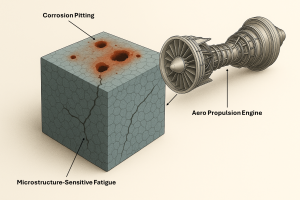QuesTek Innovations has been awarded a U.S. Navy Small Business Innovation Research (SBIR) contract to develop a breakthrough digital toolkit that predicts the life of components affected by corrosion, pitting, and fatigue. This award underscores both the critical importance of addressing corrosion fatigue in naval aerospace systems and QuesTek’s long-standing leadership in solving complex materials challenges with physics-based design approaches.
Corrosion fatigue is one of the most persistent and costly degradation mechanisms in defense and commercial aerospace. For the U.S. Navy, corrosion alone contributes to an estimated $3 to $4 billion in annual sustainment costs, while fatigue accounts for more than half of aircraft component failures. When these two mechanisms act together, they create a destructive feedback loop—where corrosion accelerates fatigue crack initiation and growth, and cyclic loading destabilizes protective films, deepening corrosion damage.

Despite its widespread impact, corrosion fatigue remains difficult to predict accurately. Traditional empirical models, based on historical testing, struggle to account for the wide variability in materials, loading conditions, environments, and manufacturing processes. The result is often costly overdesign, excessive inspection requirements, and the risk of unexpected failures.
At QuesTek, we are addressing this challenge with our proven Materials by Design® technology, which applies the principles of Integrated Computational Materials Engineering (ICME). Our physics-based, multiscale modeling approach links processing, structure, properties, and performance to enable accurate, mechanism-informed predictions. With over 25 years of experience supporting the Department of Defense, Department of Energy, and other federal agencies, we understand the demanding environments and performance expectations of mission-critical systems—and we’ve consistently delivered materials and design solutions that meet or exceed them.
In this SBIR project, we are developing a mechanistic, microstructure-sensitive corrosion fatigue lifing toolkit that integrates several state-of-the-art modeling methods, including:
- CALPHAD modeling for microstructure and phase prediction
 Phase field modeling for corrosion and pitting behavior
Phase field modeling for corrosion and pitting behavior- Atomistic modeling to capture hydrogen embrittlement and stress corrosion cracking
- Crystal plasticity finite element modeling (CPFEM) for fatigue response prediction based on microstructure
We are proud to partner with Prof. Zachary Harris of the University of Pittsburgh on this initiative. Prof. Harris is a leading researcher in the fatigue and fracture behavior of structural materials exposed to aggressive environments. His lab will lead the experimental component of the project—including material procurement, high-resolution microstructural characterization, mechanical testing, and fractographic evaluation. These validation datasets will directly inform and calibrate the predictive models within our platform. QuesTek and Prof. Harris’s team have an established collaboration, including their ongoing subscription to our ICMD® software platform for industrial corrosion and fatigue projects.
The benefits of this framework extend well beyond defense. Corrosion fatigue is a universal issue across aerospace, automotive, energy, and heavy industrial sectors. By expanding our ICMD® platform to account for corrosion, pitting, and hydrogen effects, QuesTek is further empowering commercial OEMs and suppliers to optimize durability, reduce costs, and accelerate innovation.
